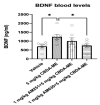Cannabinoid Receptor 2 Blockade Prevents Anti-Depressive-like Effect of Cannabidiol Acid Methyl Ester in Female WKY Rats
- PMID: 36835237
- PMCID: PMC9958868
- DOI: 10.3390/ijms24043828
Cannabinoid Receptor 2 Blockade Prevents Anti-Depressive-like Effect of Cannabidiol Acid Methyl Ester in Female WKY Rats
Abstract
The pathophysiology of major depressive disorder (MDD) is diverse and multi-factorial, yet treatment strategies remain limited. While women are twice as likely to develop the disorder as men, many animal model studies of antidepressant response rely solely on male subjects. The endocannabinoid system has been linked to depression in clinical and pre-clinical studies. Cannabidiolic Acid-Methyl Ester (CBDA-ME, EPM-301) demonstrated anti-depressive-like effects in male rats. Here, we explored acute effects of CBDA-ME and some possible mediating mechanisms, using a depressive-like genetic animal model, the Wistar-Kyoto (WKY) rat. In Experiment 1, Female WKY rats underwent the Forced swim test (FST) following acute CBDA-ME oral ingestion (1/5/10 mg/kg). In Experiment 2, Male and female WKY rats underwent the FST after injection of CB1 (AM-251) and CB2 (AM-630) receptor antagonists 30 min before acute CBDA-ME ingestion (1 mg/kg, males; 5 mg/kg, females). Serum levels of Brain-Derived Neurotrophic Factor (BDNF), numerous endocannabinoids and hippocampal Fatty Acid Amide Hydrolase (FAAH) levels were assessed. Results indicate that females required higher doses of CBDA-ME (5 and 10 mg/kg) to induce an anti-depressive-like effect in the FST. AM-630 blocked the antidepressant-like effect in females, but not in males. The effect of CBDA-ME in females was accompanied by elevated serum BDNF and some endocannabinoids and low hippocampal expression of FAAH. This study shows a sexually diverse behavioral anti-depressive response to CBDA-ME and possible underlying mechanisms in females, supporting its potential use for treating MDD and related disorders.
Keywords: Forced swim test (FST); Wistar–Kyoto (WKY); cannabidiolic acid methyl ester; endocannabinoid system; genetic animal models of depression; major depression disorder.
Conflict of interest statement
The authors declare no conflict of interest.
Figures








Similar articles
-
Unraveling the molecular basis of cannabidiolic acid methyl Ester's anti-depressive effects in a rat model of treatment-resistant depression.J Psychiatr Res. 2024 Jul;175:50-59. doi: 10.1016/j.jpsychires.2024.04.033. Epub 2024 Apr 24. J Psychiatr Res. 2024. PMID: 38704981
-
Dysfunction in fatty acid amide hydrolase is associated with depressive-like behavior in Wistar Kyoto rats.PLoS One. 2012;7(5):e36743. doi: 10.1371/journal.pone.0036743. Epub 2012 May 14. PLoS One. 2012. PMID: 22606285 Free PMC article.
-
Dual pharmacological inhibitor of endocannabinoid degrading enzymes reduces depressive-like behavior in female rats.J Psychiatr Res. 2020 Jan;120:103-112. doi: 10.1016/j.jpsychires.2019.10.010. Epub 2019 Oct 11. J Psychiatr Res. 2020. PMID: 31654971 Free PMC article.
-
The Wistar-Kyoto rat model of endogenous depression: A tool for exploring treatment resistance with an urgent need to focus on sex differences.Prog Neuropsychopharmacol Biol Psychiatry. 2020 Jul 13;101:109908. doi: 10.1016/j.pnpbp.2020.109908. Epub 2020 Mar 4. Prog Neuropsychopharmacol Biol Psychiatry. 2020. PMID: 32145362 Review.
-
Therapeutic Potential of Cannabidiol, Cannabidiolic Acid, and Cannabidiolic Acid Methyl Ester as Treatments for Nausea and Vomiting.Cannabis Cannabinoid Res. 2021 Aug;6(4):266-274. doi: 10.1089/can.2021.0041. Epub 2021 Jun 11. Cannabis Cannabinoid Res. 2021. PMID: 34115951 Free PMC article. Review.
Cited by
-
Treatment of Diet-Induced Obese Rats with CB2 Agonist AM1241 or CB2 Antagonist AM630 Reduces Leptin and Alters Thermogenic mRNA in Adipose Tissue.Int J Mol Sci. 2023 Apr 20;24(8):7601. doi: 10.3390/ijms24087601. Int J Mol Sci. 2023. PMID: 37108770 Free PMC article.
-
Increasing CB2 Receptor Activity after Early Life Stress Prevents Depressive Behavior in Female Rats.Biomolecules. 2024 Apr 10;14(4):464. doi: 10.3390/biom14040464. Biomolecules. 2024. PMID: 38672480 Free PMC article.
References
-
- Cipriani A., Furukawa T.A., Salanti G., Chaimani A., Atkinson L.Z., Ogawa Y., Leucht S., Ruhe H.G., Turner E.H., Higgins J.P.T., et al. Comparative Efficacy and Acceptability of 21 Antidepressant Drugs for the Acute Treatment of Adults With Major Depressive Disorder: A Systematic Review and Network Meta-Analysis. Focus (Madison) 2018;16:420–429. doi: 10.1176/appi.focus.16407. - DOI - PMC - PubMed
MeSH terms
Substances
LinkOut - more resources
Full Text Sources
Miscellaneous

